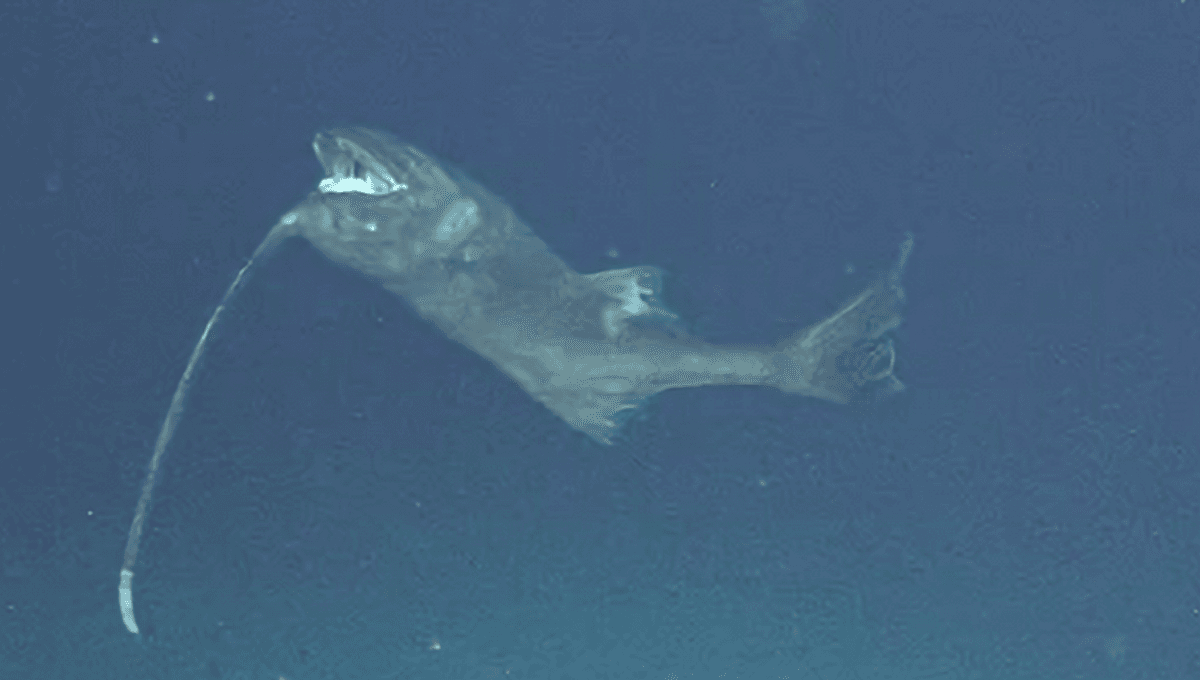
As deep-sea weirdos go, they don’t get much more bizarre than anglerfish. But if their nightmarish looks and dangly bioluminescent lures aren’t enough for you, some species of anglerfish have another strange string to their bows: they spend their whole lives upside down.
The species in question are ceratioid whipnose anglerfish from the genus Gigantactis. As you might gather from this name, they’re pretty big – some have been observed to reach lengths of 45 centimeters (18 inches), and their light-up lures can extend up to four times this.
Back in 1999, oceanographers working at the Hawaii-2 Observatory captured footage of a whipnose anglerfish hovering above the Pacific Ocean floor at a depth of around 5,000 meters (16,400 feet). When they looked closer, they were astonished to realize that the fish was swimming upside-down, something that had never been seen before.
It challenged everything ichthyologists thought they knew about the behavior of these elusive creatures. Rather than dangling their lures to attract bacteria, and consequently prey, as their more globular colleagues do, these fish seemed to be trawling them along the seafloor in search of edible deep-sea dwellers.
It was an incredible discovery, but there was a snag. Scientists couldn’t be certain whether this was normal behavior for these fish, or if they’d just happened upon a lone oddball. Observing these animals in their natural habitat is no easy task, but they needed to see more. This latest study brings together eight sightings, including one from as recently as March this year, and one at the deepest point ever recorded (5,866 meters/19,245 feet).
The evidence suggests that upside-down living is par for the course for whipnose anglerfish.
“Here we record eight more observations of inverted orientation in Gigantactis, from both sides of the Atlantic, the east Indian ocean, and the north- and south-west Pacific, suggesting that inverted swimming is perhaps the typical orientation for the genus,” the authors write in their paper.
As to why these fish have taken to backstroke, that’s less clear. The authors speculate that it could help them to detect their prey at longer distances and allow them to keep their lure well out of the way when they go in for the kill. This is especially true for those species in the genus with lures that extend very far out from their bodies.
“An inverted orientation would permit a faster and more efficient removal of the esca [lure] and illicium [rod that attaches the lure to the body] away from the prey and leave the mouth clear to strike and grasp in a curving dive,” the authors explain.
To know for sure, we’ll have to catch a whipnose anglerfish in the act of gobbling up its prey. Fortunately, it’s probably only a matter of time before that happens. As more and more remotely operated vehicles and submersibles are being deployed, researchers are finally delving into the hidden world of the deep ocean. With topsy-turvy anglerfish ticked off, who knows where this voyage of discovery will lead us next?
The study is published in the Journal of Fish Biology.
Source Link: Some Deep-Sea Anglerfish Spend Their Whole Lives Upside-Down